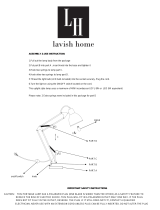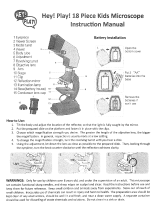
6
3. To tighten tension, turn collar in clockwise direction. Use of wide rubber band will provide a better grip on the
tension adjustment collar. It is advisable to leave controls as loose as possible, tightening only enough to keep
body tube from drifting down and out of focus from its own weight.
C. Metal parts: Use a clean, damp cloth to remove dust or dirt from metal part followed by a dry cloth.
ELECTRICAL MAINTENANCE (for models with electric substage illuminator)
WARNING: For your safety, turn switch off and remove plug from power source before replacing bulb. Make sure
that illuminator housing and lamp are cool before servicing.
A. On the bottom of illuminator housing shaft, locate locking screw that secures shaft portion to main illuminator housing.
Using screwdriver, remove completely.
B. Pull straight out on shaft to remove from main illuminator housing.
C. Note that lamp does not screw out. Remove by depressing lamp slightly and rotate in counter-clockwise direction until it
pops up slightly.
D. Replace with a 115-130v 15 watt lamp with double contact, medium bayonet base. This is a standard, commonly used
microscope replacement bulb. It is also available from National, specifying replacement part #800-101. Do not use
higher than 15 watt bulb. Depress lamp slightly and rotate in clockwise direction.
E. Carefully wipe new lamp to insure that it is clean and free of all fingerprints. Gently depress lamp into socket and rotate
counter clockwise.
F. Insert shaft into main illuminator housing and secure with locking screw.
CORDLESS ILLUMINATOR (for models with rechargeable illuminators)
The extent of electrical maintenance, by other than a qualified technician, should be battery recharging and battery
replacement. Before maintenance, be sure that recharger is not connected to microscope.
A. Recharging Batteries: Plug output cord from battery charger into DC recharging socket located on side of illuminator.
Your automatic switching recharger operates on 100 to 240 volts AC 50/60 Hz, plug recharger into your AC wall outlet.
The red LED indicator lamp located on recharger will be illuminated when batteries are receiving maximum charge.
After batteries are charged, the red LED indicator lamp will turn to green and charger automatically switches to “trickle
charge”. The charger can be left plugged in, but for safety reasons it is a good idea to disconnect the charger from the
AC wall outlet and the output cord from recharging socket after 12 hours. Batteries and charger may feel warm when
charging, and unplugging the recharger is a safety precaution.
B. Replacing Batteries: Your microscope includes 3 rechargeable AA nickel hydride batteries. These may be recharged
up to 1000 times, but if you observe that a recharge is providing significantly less than 40 hours of operation, it is
probably time to replace the batteries.
IMPORTANT WARNING: DO NOT USE REGULAR ALKALINE BATTERIES IN THIS MICROSCOPE. ANY ATTEMPT
TO RECHARGE ALKALINE TYPE BATTERIES COULD RESULT IN BATTERIES EXPLODING.
Gently lay microscope on its side or back. Observe battery compartment cover located on bottom of illuminator. Using
a small Phillips screwdriver, carefully remove the two Phillips screws that secure battery cover to bottom of illuminator.
Slide battery cover straight back to remove and expose batteries. Remove all 3 batteries and replace with new
rechargeable AA nickel metal hydride batteries, making certain to insert with correct polarity according to markings on
battery holder. Replace battery cover and secure with the two Phillips screws.
Follow instructions on new battery packaging to determine if they are already charged, or if they should be charged
before initial use. If recharging is required, following directions in “A.” above.
C. Replacing LED Element: Do not attempt to disassemble any “LED” bulb components. Consult an expert technical
service company when the LED “bulb” needs replacement or return the illuminator to National for repair.
An LED “bulb” will last up to 100,000 hours, so you don’t have to do this exercise very often.









